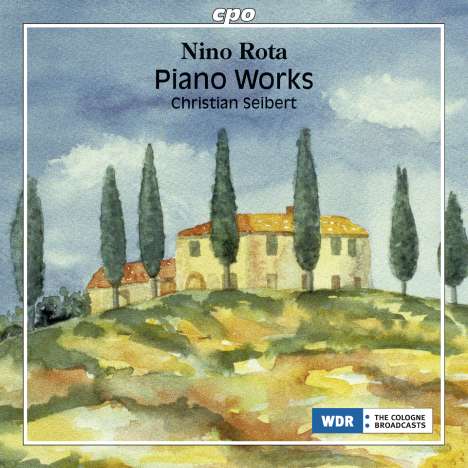Nino Rota: Klavierwerke auf CD
Klavierwerke
Herkömmliche CD, die mit allen CD-Playern und Computerlaufwerken, aber auch mit den meisten SACD- oder Multiplayern abspielbar ist.
Lassen Sie sich über unseren eCourier benachrichtigen, falls das Produkt bestellt werden kann.
Bach-Variationen; 15 Preludi; Walzer; Ippolito Gioca; 7 Pezzi difficili per Bambini; Fantasia G-Dur
- Künstler:
- Christian Seibert (Klavier)
- Label:
- CPO
- Aufnahmejahr ca.:
- 2012
- UPC/EAN:
- 0761203501922
- Erscheinungstermin:
- 20.3.2016
Ähnliche Artikel
Klavierwerke mit nachhaliger Qualität
Nino Rotas Beziehung zum Klavier war außergewöhnlich. Sein Großvater mütterlicherseits, Giovanni Rinaldi, war ein bekannter Komponist, der vor allem für dieses Instrument schrieb. Ninos Mutter schrieb in ihrem Bericht »Storia di Nino: ›Mit acht Jahren improvisierte Nino am Klavier und produzierte so natürlich Harmonien, als würden die Tasten es selbst für ihn erledigen. Als sein Vater sah, wie ich mit offenem Mund zuhörte, fragte er mich zweifelnd: ›Denkst Du, er hat wirklich Talent, oder betrügen wir uns nur selbst, wie Eltern das so machen?‹ Nein, Ninos Eltern irrten sich nicht, ihr Sprössling war ein Wunderkind. Bedenkt man Nino Rotas enges Verhältnis zum Klavier, so ist es umso erstaunlicher, dass sein Oeuvre diesbezüglich überschaubar ist. Vierzehn Opusnummern mit Klaviermusik kommen zusammen, Jugendwerke mit eingeschlossen. Größere Klavierwerke legen Zeugnis davon ab, dass J. S. Bach für Nino Rota ein wichtiger Bezugspunkt war 1950 entstanden die Variationen und Fuge im zwölften Ton auf den Namen Bach: Eine prachtvolle Fuge bestehend aus einem höchst chromatischen Gebilde, das für den Pianisten eine wahre Herausforderung bedeutet und den komplexen Werken eines Max Reger durchaus ebenbürtig ist. Die 15 Preludi bilden das ambitionierteste Werk, das Rota für Soloklavier komponiert hat. Auch diese Musik ist bereits in den ersten vier ‹Preludi« stark mit chromatisch ab- und aufsteigenden Motiven durchsetzt.
Product Information
Piano Compositions of Enduring Quality
Nino Rota's relationship with the piano was extraordinary. His maternal grandfather, Giovanni Rinaldi, was a well-known composer who wrote primarily for this instrument. In his mother's »Storia di Nino« (Nino's Story) we read as follows: »At the age of eight Nino was improvising on the piano and producing harmonies so naturally that it was as if the keys were doing it for him on their own. When his father saw how I listened with open mouth, he asked me in a skeptical way, ›Do you think he really has talent, or are we only fooling ourselves, as parents do?‹« No, Nino's parents were not mistaken; their son was a child prodigy. Considering Nino Rota's close relationship with the piano, it is all the more astonishing that his oeuvre for this instrument is not all that extensive: a total of fourteen opus numbers with piano music, including works from his youth. His piano compositions of larger scope attest to Bach's role as an important point of orientation for him. In 1950 he wrote the Variations and Fugue in Twelve Tones on the Name of Bach, a work with a magnificent fugue consisting of a most highly chromatic structure posing a genuine challenge to the pianist and in every way equal to Max Reger's complex works. The most ambitious work composed by Rota for solo piano is formed by the 15 Preludi. Here too motifs in chromatic ascent and descent already pervade the very first four preludes.
Rezensionen
klassik-heute.com 06/2016: »Seibert spielt Rotas Musik ebenso brillant wie gefühlvoll. Er lässt - mit stupender Technik - auch mal den Virtuosen agieren, trägt dabei aber nie zu dick auf. Seine Stärke liegt vielmehr in einer sehr differenzierten Anschlagstechnik, die klangliche Ebenen klar voneinander abstuft ohne dabei schematisch vorzugehen. Das schafft geradezu berückende Momente, etwa in der Fantasia in G, wenn Seibert in emphatischer Weise ganz großes, theatralisches Kino inszeniert. Klarer Fall: Hier widerfährt einem zu Unrecht verkannten Komponisten Gerechtigkeit.«Disk 1 von 1 (CD)
Variationen und Fuge im 12. Ton über den Namen BACH
-
1 Proposta
-
2 Variation 1: Mosso, deciso
-
3 Variation 2: Tranquillo, scorrevole
-
4 Variation 3: Allegro vivace
-
5 Variation 4: Adagio
-
6 Variation 5: Allegro
-
7 Variation 6: Andante
-
8 Variation 7: Allegro vivace
-
9 Variation 8: Poco meno mosso, con liberta
-
10 Variation 9: Andante tranquillo
-
11 Variation 10: Allegro vivace
-
12 Variation 11: Sostenuto poco maestoso
-
13 Variation 12: Lo stesso tempo, agitato
-
14 Fuga
Préludes Nr. 1-15
-
15 Nr. 1 Allegro molto
-
16 Nr. 2 Allegro, ma espressivo e delicato
-
17 Nr. 3 Allegretto con spirito
-
18 Nr. 4 Andante sostenuto es espressivo
-
19 Nr. 5 Con impeto
-
20 Nr. 6 Andante
-
21 Nr. 7 Allegro, con spirito
-
22 Nr. 8 Lento, con accento
-
23 Nr. 9 Allegretto quasi andantino
-
24 Nr. 10 Allegro mosso e marcato
-
25 Nr. 11 Andante senza lenteza
-
26 Nr. 12 Allegro
-
27 Nr. 13 Andante cantabile
-
28 Nr. 14 Allegro non troppo e marcato
-
29 Nr. 15 Allegro robusto
-
30 Walzer für Klavier
-
31 Ippolito gioca
Schwere Stücke für Kinder Nr. 1-7
-
32 Nr. 1 Salti e giochi
-
33 Nr. 2 Grillo notturno: Lento
-
34 Nr. 3 Capriccio: Allegro
-
35 Nr. 4 Cantilena
-
36 Nr. 5 Le scalette
-
37 Nr. 6 Puccettino nella Giungla
-
38 Nr. 7 L'acrobata
-
39 Fantasie für Klavier G-Dur
Mehr von Nino Rota
-
Nino RotaI Due Timidi2 CDsAktueller Preis: EUR 29,99
-
Nino RotaMusik für Viola & KlavierCDVorheriger Preis EUR 17,99, reduziert um 0%Aktueller Preis: EUR 4,99
-
Nino RotaDivertimento concertante für Kontrabass & OrchesterCDAktueller Preis: EUR 19,99
-
Nino RotaSonate für Klarinette & KlavierCDVorheriger Preis EUR 14,99, reduziert um 0%Aktueller Preis: EUR 6,99
















